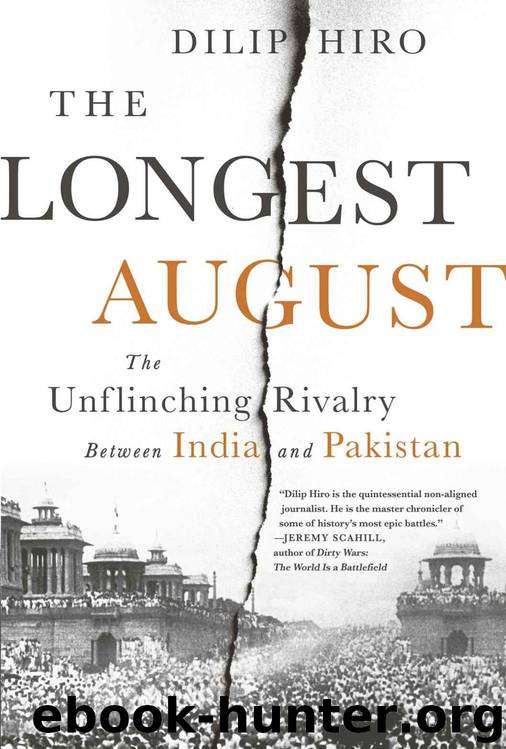The Longest August: The Unflinching Rivalry Between India and Pakistan by Dilip Hiro

Author:Dilip Hiro [Hiro, Dilip]
Language: eng
Format: epub
Tags: Non-Fiction
ISBN: 9781568587349
Amazon: 1568587341
Publisher: Nation Books
Published: 2015-02-24T08:00:00+00:00
Proxy Wars on Track
While the overtly conducted war games and diplomacy ended satisfactorily, the proxy war by India and Pakistan through RAW and the ISI intensified in 1987. In Afghanistan KHAD and the KGB increased their training and arming of the Baluchi nationalists for subversive activities in Baluchistan. The separatists’ aim of establishing an independent Baluchistan would have meant reducing Pakistan by a hefty 43 percent and was therefore resisted bitterly by the government in Islamabad. As part of the KHAD-RAW-KGB triad, RAW’s Counter Intelligence Team-X became an active participant in stoking subversion in Pakistan. It coordinated its activities with KHAD. The result was a low-level but steady campaign of bombings in Karachi, Lahore, and Multan. According to the US State Department, more than half of the 835 terrorist incidents worldwide in 1987 were in Pakistan.50
Indian Punjab remained on the boil. In Amritsar, militants had started creeping into the Golden Temple from the summer of 1986. Their takeover was complete in June 1987, when Darshan Singh Ragi, the Sikhs’ supreme leader opposed to violence, was forced to flee the shrine because of serious threats to his life. This was a signal for the Delhi government to impose central rule in Punjab. (It would continue until February 1992.)
To ensure that the proxy war did not escalate to the extent that it made hot war inevitable, Zia ul Haq conceived the idea of a clandestine meeting between the heads of the ISI and RAW. But he needed an obliging but influential intermediary with extraordinary finesse to achieve this aim. During his military assignment in Jordan, he had cultivated a friendship with Crown Prince Hassan bin Talal, whose Cambridge-educated, Pakistani wife, Sarvath Ikramullah, was born in Kolkata and was a niece of Hussein Shaheed Suhrawardy, the former Pakistani premier. Hassan bin Talal agreed to act as go-between. He succeeded in contacting Rajiv Gandhi’s office.
With the authorization of their respective leaders, Lieutenant General Hamid Gul, director general of the ISI (in office March 1987–October 1989), and RAW chief A. K. Verma met in Amman to discuss their mutual problems. In exchange for the phased handing over of the nearly three thousand militant Sikhs who had crossed into Pakistan, Verma promised to de-escalate the bombing campaign in Pakistani cities in stages.51 They met again in the Swiss town of Interlaken, this time focusing on the India-occupied Siachen Glacier in Kashmir, but made no progress.
In Indian Punjab, operating from the safety of the Golden Temple, the armed militants of the Bhindranwale Tiger Force and the Khalistan Commando Force of the Pakistan-based Paramjit Singh Panjwar52 would go out to murder prominent Punjabi politicians, police, and army officers, as well as suspected informers and innocent Hindus. Equally, the security forces carried out extrajudicial killings, attributing them to fake “encounters.” The photographs of these Sikh “martyrs” adorned the walls of many buildings in the Golden Temple complex.53
Militant Sikhs operated in an environment in which Sikh and Hindu communities were alienated. With the terrorists increasingly carrying deadly AK-47 assault rifles,
Download
This site does not store any files on its server. We only index and link to content provided by other sites. Please contact the content providers to delete copyright contents if any and email us, we'll remove relevant links or contents immediately.
The Secret History by Donna Tartt(16684)
The Social Justice Warrior Handbook by Lisa De Pasquale(11499)
Thirteen Reasons Why by Jay Asher(7814)
This Is How You Lose Her by Junot Diaz(5808)
Weapons of Math Destruction by Cathy O'Neil(5061)
Zero to One by Peter Thiel(4841)
The Myth of the Strong Leader by Archie Brown(4798)
Promise Me, Dad by Joe Biden(4463)
Beartown by Fredrik Backman(4448)
How Democracies Die by Steven Levitsky & Daniel Ziblatt(4434)
Stone's Rules by Roger Stone(4427)
The Fire Next Time by James Baldwin(4357)
100 Deadly Skills by Clint Emerson(4095)
A Higher Loyalty: Truth, Lies, and Leadership by James Comey(4046)
Rise and Kill First by Ronen Bergman(4029)
The David Icke Guide to the Global Conspiracy (and how to end it) by David Icke(3900)
The Farm by Tom Rob Smith(3884)
Secrecy World by Jake Bernstein(3794)
The Doomsday Machine by Daniel Ellsberg(3743)
